#reactjs for dashboards and data visualization
Explore tagged Tumblr posts
Text
0 notes
Text
Why Hiring ReactJS Developers from Brain Inventory Can Accelerate Your Front-End Success
In the ever-evolving digital world, delivering seamless, fast, and dynamic user experiences is critical. Today’s users expect intuitive interfaces, lightning-fast interactions, and responsive layouts across all devices. This is where ReactJS excels—and why many forward-thinking businesses are choosing to hire ReactJS developers who can build high-performing applications tailored to modern user expectations.
At Brain Inventory, we offer top-tier ReactJS development services that help you build scalable, interactive, and visually appealing front-end applications. Whether you’re a startup, SMB, or enterprise, we provide the expertise, flexibility, and dedication you need to bring your digital vision to life.

What Makes ReactJS a Powerful Choice for Modern Front-End Development?
ReactJS is a popular open-source JavaScript library developed by Facebook for building user interfaces, particularly single-page applications where fast rendering and user interaction are essential.
Here’s why ReactJS continues to dominate front-end development:
⚡ Fast Rendering with Virtual DOM ReactJS updates only the components that change, resulting in quicker UI updates and superior performance.
🧱 Component-Based Architecture Developers can build reusable UI components, making the codebase more manageable and efficient.
🔄 One-Way Data Binding Ensures consistent and predictable application behavior.
🌐 Rich Ecosystem Backed by a strong community and rich libraries for everything from routing to state management.
When you hire dedicated ReactJS developers from Brain Inventory, you tap into all these advantages—combined with expert implementation and modern design practices.
Why Hire ReactJS Developers from Brain Inventory?
At Brain Inventory, we don’t just provide developers—we offer complete front-end excellence. Our ReactJS developers are experts at building engaging, maintainable, and scalable interfaces that help your product stand out.
✅ Experienced Front-End Experts
Our developers bring years of experience in ReactJS and its ecosystem, including Redux, Next.js, React Router, and more. They are adept at building everything from simple SPAs to complex enterprise-grade front-ends.
✅ Customized UI Solutions
We don’t believe in one-size-fits-all. We create tailored solutions that reflect your brand, resonate with your users, and work flawlessly across all platforms.
✅ Flexible Hiring Models
Whether you want to hire dedicated ReactJS developers for long-term projects or need short-term support, Brain Inventory offers flexible engagement options to suit your needs.
✅ Agile Development & Transparent Process
With clear timelines, daily updates, and agile sprint cycles, we keep your project on track and you in the loop at every stage.
Services Offered by Our ReactJS Developers
By partnering with Brain Inventory, you get access to a wide range of ReactJS development services, including:
🔹 Custom ReactJS Web Application Development
🔹 UI/UX Design and Front-End Architecture
🔹 ReactJS Migration and Upgrades
🔹 Progressive Web Apps (PWAs)
🔹 Single-Page Application (SPA) Development
🔹 Integration with APIs and Back-End Systems
🔹 Ongoing Maintenance and Optimization
Whether you're starting from scratch or scaling an existing application, our ReactJS experts have you covered.
Industries We Serve
Brain Inventory’s ReactJS developers have built and optimized solutions for various industries, including:
🏥 Healthcare – Patient portals, telemedicine platforms
🛍️ Retail & E-commerce – Interactive storefronts, custom shopping carts
🎓 EdTech – E-learning portals, performance dashboards
🏦 FinTech – Secure and dynamic user dashboards
📊 SaaS – Admin panels, data visualization tools
Client Success Story: Building a High-Performance SaaS Dashboard
One of our SaaS clients needed a responsive admin dashboard capable of handling large data volumes in real time. Our dedicated ReactJS developers:
Designed a sleek and modern UI
Implemented virtual DOM for seamless data rendering
Integrated real-time analytics and charts using D3.js and Redux Delivered a fully functional product in under 10 weeks
This solution helped the client improve user retention by 35% and reduced load times by 50%.
Benefits of Hiring Dedicated ReactJS Developers
By choosing to hire dedicated ReactJS developers from Brain Inventory, you ensure:
✅ Full Control Over Resources
✅ Quick Project Start and Ramp-Up
✅ Direct Communication and Fast Response Times
✅ High Code Quality and Scalable Architecture
✅ On-Time Delivery and Post-Launch Support
Our developers integrate smoothly with your team and processes, acting as an extension of your internal workforce.
Final Thoughts
ReactJS is the cornerstone of modern web development, enabling businesses to create lightning-fast and interactive user interfaces. But the key to success lies in hiring developers who truly understand the framework, its ecosystem, and how to use it to build great user experiences.
Brain Inventory is your trusted partner to hire ReactJS developers who are dedicated, experienced, and aligned with your vision. Whether you need full-time support or project-based collaboration, our team is ready to bring your front-end goals to life.
Ready to transform your front-end with ReactJS? Hire dedicated ReactJS developers from Brain Inventory today.
0 notes
Text
13 Best React Frameworks and Libraries to Use in 2025
React or ReactJs is one of the most popular JavaScript front-end libraries for developing amazing user interfaces. Today, more than 40% of developers prefer ReactJs. One of the key reasons for its immense popularity is its wide range of React Frameworks and Libraries for extended functionalities.
These React js frameworks allow you to speed up your development process and create scalable and high-performing UI for web and mobile applications.
In this blog, we have listed the best React Frameworks and Libraries that can help you to create awesome apps.
Best React Frameworks and Libraries for 2025
ReactJs has improved, providing developers with different frameworks and components to ease UI development. Overall, the NPM trend is increasing for top react frameworks as follows:

Let’s explore the best React Frameworks and Libraries in 2025 for efficient, scalable, and dynamic user interfaces for mobile and web applications.
1. Material Tailwind – React
Material Tailwind is a popular design system and component library. You can use it with React to create cool web apps. It combines the good looks of Material Design with the practicality of Tailwind CSS.
You get lots of ready-made parts and styles to make your app look great without much effort. If you want to build nice and easy-to-use web apps, Material Tailwind for React is a must-have handy tool.
Features-
Tailwind CSS with Material Design
Prebuilt components library
Easy customization
Responsiveness built-in
Tailwind CSS Integration
Dark mode support
2. Redux
Redux remains a vital state management library in the React community. It offers a smart approach to handling your app’s state and simplifies managing complex data flow.
With a rich set of middleware and tools, Redux keeps React applications well-organized, scalable, and efficient in managing their states.
Features-
State Management
Predictable State Updates
Centralized Store
Unidirectional Data Flow
Middleware Support
DevTools Integration
Community Ecosystem
3. Create a React App
Create React App streamlines the setup of new React projects. It provides a ready-to-go environment with a development server, build scripts, and necessary tools, enabling developers to dive into coding immediately without configuration headaches.
With ongoing updates to adapt to changes in the React ecosystem, Create React App remains a convenient option for rapid project launches.
Features-
Rapid Setup
Pre-configured Environment
Build Scripts
Zero Configuration
Dependency Management
Hot Reloading
Integrated Testing
4. Rebass
Rebass simplifies UI development in React, offering responsive and cohesive components. With an emphasis on design principles and minimalism, Rebass delivers customizable and themeable UI elements. It’s a great pick for effortlessly crafting visually appealing and user-friendly React apps.
Features-
Simplified UI Development
Responsive Components
Consistency Across Interfaces
Design Principles Emphasis
Minimalistic Approach
Highly Customizable
Themeability
Aesthetic Appeal
5. React Admin
React Admin is a framework designed to build admin interfaces and dashboards. You can develop data-intensive applications using features like CRUD operations and efficient data handling.
With its focus on robust data and user management functionalities, React Admin proves to be an indispensable tool for developers.
Features-
Admin Interface and Dashboard Development
Streamlined Data-Heavy Application Development
CRUD Operations Support
Efficient Data Handling
Robust Data Management Functionalities
User Management Functionalities
Customizable Interface Components
Extensive Plugin Ecosystem
6. Ant Design
Ant Design is a widely-used UI library providing a diverse collection of meticulously crafted components for creating polished and intuitive applications.
It offers a variety of customizable elements like forms, tables, and navigation tools to simplify the React JS development services process, enabling the creation of sophisticated yet user-friendly React applications.
Features-
Comprehensive UI Component Library
Meticulously Designed Components
Customizable Elements
Support for Forms
Feature-rich Tables
Navigation Components
Responsive Design
Theming and Styling Options
7. Grommet
Grommet stands out as a React UI component library celebrated for its emphasis on accessibility and ease of use. Equipped with a suite of pre-built components, it places a strong focus on responsiveness and accessibility, making it an ideal choice for developers aiming to craft user-friendly web applications that meet accessibility standards.
Features-
Accessibility-Centric Design
User-Friendly Components
Responsive Layouts
Ready-to-Use Components
Simplified Development Process
Compliance with Accessibility Standards
Customization Options
Seamless Integration with React
8. Material UI
Material UI stands as a robust UI framework grounded in Google’s Material Design principles. Its array of meticulously crafted components simplifies the creation of visually striking and responsive user interfaces.
Renowned for its popularity and extensive community backing, Material UI remains a go-to option for ReactJS developers seeking to align with the Material Design aesthetic.
Features-
Material Design-Based Components
Visually Appealing Interfaces
Responsive Design
Extensive Component Library
Theming Support
Accessibility Features
Utility classes
Rich icons set
Component customization
9. Semantic UI
React Semantic UI is a development framework designed to craft visually appealing and responsive layouts using easily understandable HTML. It leans heavily on the semantic style of HTML, where each CSS class holds a clear meaning.
In Semantic React UI, words and classes are interchangeable, with classes structured like natural language to intuitively link concepts. Additionally, it employs straightforward phrases known as behaviors to activate specific functionalities.
Features-
Semantic HTML Structure
Semantic CSS Classes
Intuitive Class Syntax
Interchangeable Concepts
Behavior-driven Functionality
Responsive Layouts
Comprehensive Component Library
Theming Support
10. React Spinner
React Spinner is a library tailored to bring loading spinners and animations to React-based JavaScript apps.
It streamlines the integration of loading indicators, offering a range of customizable spinners to enhance user experience, particularly during data loading or process completion.
With React Spinner, you can elevate the visual appeal of web apps, keeping users engaged and minimizing bounce rates during loading periods.
Features-
Loading Spinner Animations
Simplified Integration
Customizable Options
Enhanced User Experience
Bounce Rate Reduction
Compatibility
Lightweight
Responsive Design
11. React Bootstrap
React Bootstrap merges the capabilities of React with the widely-used Bootstrap framework, simplifying the development of visually appealing and responsive web applications.
By providing a suite of Bootstrap components tailored for React, it facilitates the creation of mobile-friendly, consistent, and aesthetically pleasing user interfaces.
Features-
React and Bootstrap Combined
Responsive Apps Made Easy
Ready-to-Use React Components
Mobile-Friendly Interface Creation
Consistent Design Across Devices
Simple UI Development
Utilizes Bootstrap Utility Classes
12. Blueprint
Blueprint is a UI toolkit built on React, featuring carefully crafted components for creating stylish and adaptable web apps.
Prioritizing simplicity, functionality, and cohesive design, Blueprint offers a diverse array of elements, including buttons, forms, and data visualizations. It’s an essential tool for developers striving to craft sophisticated and professional web applications.
Features-
React-Based UI Toolkit
Meticulously Designed Components
Focus on Simplicity and Functionality
Unified Design Language
Wide Range of UI Elements
Button and Form Components
Data Visualization Options
Professional and Polished Web Applications
13. React-Motion
React-Motion empowers developers to craft fluid and interactive animations within React applications. Leveraging physics-based animation principles, it injects vitality into web interfaces.
With React-Motion, you can seamlessly integrate captivating animations that elevate user engagement, rendering it indispensable for projects seeking compelling visual effects.
Source of Content URL: Top 13 React Frameworks
#ReactFrameworks#Reactframeworkscomparison#BestReactframeworks#Reactframeworksforwebdevelopment#Reactframeworks2025#PopularReactframeworks#Reactframeworksandlibraries
0 notes
Text
ERP Software Company in Kochi

Introduction
Kochi, the commercial capital of Kerala, is witnessing a surge in digital transformation across industries such as shipping, IT, tourism, manufacturing, and retail. One of the primary technologies accelerating this change is Enterprise Resource Planning (ERP). This blog explores the growing demand and offerings of ERP software companies in Kochi, the advantages they bring to various sectors, and how businesses can leverage SEO-optimized ERP development services for visibility and growth.
What is ERP Software?
ERP is a centralized business management solution that integrates various core functions—such as finance, human resources, inventory, production, and customer relationship management—into one seamless platform.
Core ERP Modules:
Financial Accounting
Inventory and Warehouse Management
Human Resource Management
Customer Relationship Management (CRM)
Manufacturing and Production Planning
Procurement and Supply Chain Management
Project Management
Business Intelligence & Reporting
Importance of ERP Software in Kochi's Business Landscape
1. Shipping and Logistics
ERP helps in managing fleet operations, cargo tracking, freight billing, and port logistics with real-time data accuracy.
2. Tourism and Hospitality
Enhances booking systems, inventory, guest experiences, HR, and payroll management in resorts and hotels.
3. Manufacturing Units
Supports production scheduling, raw material procurement, quality control, and equipment maintenance.
4. Retail and E-commerce
Provides centralized stock management, real-time sales analytics, and POS system integrations.
5. Healthcare Institutions
Streamlines patient record systems, billing, compliance, and hospital inventory management.
Benefits of ERP Software for Kochi-Based Enterprises
Enhanced Productivity
Centralized Information Access
Improved Financial Control
Efficient Resource Allocation
Regulatory Compliance and Reporting
Custom Dashboard and KPIs Monitoring
Remote and Mobile Access with Cloud ERP
Multi-language and Multi-currency Support
Top ERP Software Companies in Kochi
1. Infopark Solutions Pvt. Ltd.
Specialized in scalable ERP systems for manufacturing and export businesses.
2. KochiSoft ERP Developers
Offers modular and cloud-based ERP with CRM and HR integration.
3. Zerone Technologies
Known for robust and secure ERP software for financial institutions and logistics firms.
4. NavAlt Technologies
Focuses on maritime, marine, and industrial ERP customization.
5. Techno Globe ERP Solutions
Delivers enterprise-grade ERP with IoT, AI, and automation features for large organizations.
Custom ERP Development vs. Ready-Made Software
Feature Custom ERP Ready-Made ERP Personalization Fully customizable Limited customization Cost Higher initial investment Lower upfront cost Integration Seamless with existing tools May require APIs Scalability Highly scalable Depends on vendor Time to Deploy Longer Quicker setup
Technologies Used in ERP Development in Kochi
Languages: Python, Java, PHP, C#
Frameworks: Odoo, SAP, Oracle NetSuite, ASP.NET
Databases: PostgreSQL, MySQL, Oracle, MS SQL
Platforms: AWS, Azure, On-premise Servers
UI/UX: ReactJS, Angular, Bootstrap
Mobile: Flutter, Kotlin, Swift for mobile ERP apps
Industries That Benefit Most from ERP in Kochi
Maritime and Logistics Companies
Coir and Agro-Based Exporters
Rubber and Chemical Manufacturers
Multi-chain Retailers and Wholesalers
Educational Institutes and Universities
Ayurveda and Wellness Centers
Hospitals and Diagnostic Labs
Tourism and Hotel Groups
Future Trends in ERP Development in Kochi
AI-Driven Forecasting and Predictive Analytics
Blockchain in ERP for Transparent Supply Chains
IoT-Integrated Smart Manufacturing ERP
Chatbot Integration and Voice Commands
Augmented Reality (AR) for Real-time Data Visualization
Conclusion
ERP software companies in Kochi are playing a vital role in modernizing business operations, enhancing productivity, and delivering data-driven insights. From SMEs to large-scale industries, ERP adoption is no longer optional but essential. Custom ERP development tailored to local business needs is empowering Kochi-based enterprises to thrive in an increasingly competitive marketplace.
0 notes
Text
Best Web Development Company in Ekkaduthangal -1

Looking for the Leading Web Development Company in Ekkaduthangal to Boost Your Online Presence? You’re in the right place! In today’s rapidly evolving digital space, having a strong online presence is no longer optional — it’s essential. This blog will help you find the most dependable and budget-friendly web development service provider in Ekkaduthangal who can turn your business ideas into reality.
Why Partner with a Professional Web Development Company in Ekkaduthangal?
Choosing a top Web Development Agency in Ekkaduthangal plays a vital role in your business growth. It ensures your website is not just visually attractive but also technically robust. From loading speed and mobile responsiveness to SEO compatibility — every factor contributes to success.
Top Advantages:
Tailor-Made Website Solutions
Lightning-Fast Page Loading
Search Engine Optimized Layout
Fully Responsive Across All Devices
Safe, Secure & Scalable Infrastructure
Services Offered by a Premier Web Development Company in Ekkaduthangal
A reputed web development firm offers comprehensive services that suit diverse business needs.
1. Custom Website Design & Development
We develop unique websites built specifically around your brand, using clean code to deliver high performance.
2. Ecommerce Website Solutions
Launch a secure, user-friendly online store with integrated payment systems, inventory tools, and analytics dashboards.
3. CMS Website Development
Effortlessly manage your content with intuitive platforms such as WordPress, Joomla, or Drupal.
4. Web Application Development
Build advanced web applications like CRM, ERP, or LMS to enhance business productivity.
5. UI/UX Design Services
Our creative experts design interactive, visually appealing websites with smooth user navigation and great usability.
Technologies Used by Top Web Developers in Ekkaduthangal
We implement the latest technologies and frameworks to ensure speed, security, and scalability.
Front-End Development: HTML5, CSS3, JavaScript ReactJS, Angular, VueJS
Back-End Development: PHP (Laravel, CodeIgniter) NodeJS, Python (Django)
Database Technologies: MySQL, PostgreSQL, MongoDB
CMS Platforms: WordPress, Shopify, Magento, OpenCart
Our Web Development Process – A Step-by-Step Workflow
We follow a well-structured approach to deliver quality websites that meet your goals.
Requirement Gathering
Planning & Strategy
Wireframing & Prototyping
UI/UX Design & Coding
Testing & Quality Assurance
Final Deployment
Ongoing Maintenance & Support
Industries We Cater To
We provide web development solutions to a wide range of sectors:
E-commerce & Retail
Education & E-Learning
Healthcare & Wellness
Financial Services
Logistics & Transportation
Travel & Tourism
What Makes Us the Best Web Development Company in Ekkaduthangal?
1. Affordable Pricing Models
Get high-quality services that fit your budget without compromising performance.
2. Dedicated Technical Support Team
Our expert support team is available 24/7 to assist with any issues or queries.
3. SEO-Optimized Development
We build websites with strong SEO foundations to help you rank higher on Google.
4. Quick Turnaround Time
We deliver your project on time while maintaining top-notch quality.
5. High Security & Performance
We use secure coding practices, SSL integration, and advanced firewall setups to keep your data protected.
Why Clients Trust Us As the Best Web Development Partner in Ekkaduthangal
Expert Professionals: Our team includes skilled developers, designers, and project coordinators with vast industry experience.
Transparent Pricing: Clear cost structures with no hidden charges or surprises.
Scalable Architecture: Our solutions are built to grow with your business.
Impressive Portfolio: With over 1000+ successful projects, our track record speaks for itself.
Client Testimonials
⭐ “Absolutely the best web development company in Ekkaduthangal. After launching our new website, we noticed a 3X increase in leads!” ⭐ “The team is highly professional and delivers on time. Ideal for startups and small businesses.”
Frequently Asked Questions (FAQs)
Q1. Why hire a local web development company in Ekkaduthangal? A local agency offers better communication, tailored support, and faster turnaround times.
Q2. What is the cost of building a website? The price depends on your requirements. Contact us for a personalized quote.
Q3. Will I be able to manage the website content myself? Yes, our CMS-based websites let you update and manage content easily without coding skills.
Q4. How long does it take to build a website? A basic website usually takes 7–15 days, while advanced projects may take up to 30+ days.
Q5. Do you offer SEO services as well? Yes, we provide complete SEO solutions to enhance your website’s visibility online.
Conclusion – Choose the Best Web Development Company in Ekkaduthangal
Choosing a trusted web development company in Ekkaduthangal can revolutionize your online presence. From building high-performing websites to boosting your business conversions, we’re here to help you succeed. Let’s build a future-ready website together — contact us today to get started.Remember, the right web development company is an investment in your business’s future success for more about visit pugazhvi Blog.
0 notes
Text
Why Use ReactJS? A Beginner's Guide to the Popular Frontend Framework In the rapidly evolving world of web development, choosing the right tools can make all the difference in your project’s success. One such tool that has garnered immense popularity among developers is ReactJS. But what makes it so special? Let’s dive into the reasons why ReactJS should be your go-to choice for building modern web applications. 1. What is ReactJS? ReactJS is a JavaScript library developed by Facebook for building user interfaces, particularly single-page applications. Released in 2013, it quickly gained traction for its innovative approach to web development. React simplifies the process of creating dynamic and responsive UI components, making it a favorite among developers. 2. Why Choose ReactJS? a) Component-Based Architecture React follows a component-based architecture that allows developers to break down the UI into reusable pieces. Each component is self-contained, which makes the code easier to manage, debug, and test. This modular approach also promotes reusability and scalability, saving you time and effort in the long run. b) Virtual DOM for Performance Optimization One of React’s standout features is its Virtual DOM (Document Object Model). Instead of directly manipulating the actual DOM, React creates a lightweight copy. When changes occur, React compares the new Virtual DOM with the previous version and updates only the parts that have changed. This minimizes expensive DOM manipulations, resulting in faster and smoother performance. c) Rich Ecosystem and Tools React boasts a rich ecosystem that includes libraries, tools, and extensions to enhance development. Whether you need state management with Redux or MobX, routing with React Router, or server-side rendering with Next.js, React has you covered. Its vibrant community ensures a constant flow of resources and support. d) Declarative Syntax React’s declarative syntax makes it easier to understand and write. Developers describe what they want to achieve, and React takes care of the “how.” This approach simplifies debugging and reduces the likelihood of errors. e) Learn Once, Write Anywhere React’s versatility extends beyond web development. With React Native, you can use your React knowledge to build mobile applications for iOS and Android, broadening your skill set and potential career opportunities. 3. Use Cases of ReactJS ReactJS is suitable for a wide range of applications, including: Single-Page Applications (SPAs): For dynamic websites with seamless navigation. E-Commerce Platforms: For interactive and engaging user interfaces. Social Media Applications: Many features of Facebook, Instagram, and WhatsApp are powered by React. Dashboard Applications: For data visualization and analytics. 4. How React Compares to Alternatives While there are other frontend frameworks like Angular and Vue.js, React stands out for its simplicity and flexibility. Unlike Angular’s more opinionated structure, React lets you pick and choose tools, giving you greater control over your project’s architecture. Vue.js is also a strong contender but lacks the extensive ecosystem and community support that React offers. 5. Getting Started with ReactJS If you’re ready to give React a try, here’s how to start: Set Up Your Environment: Install Node.js and npm (Node Package Manager). Create a New Project: Use the create-react-app command for a hassle-free setup. Learn JSX: JSX is React’s syntax extension for JavaScript that allows you to write HTML-like code within JavaScript. Understand State and Props: These are essential concepts for managing data and interactions in React. Experiment with Components: Start by building simple components and gradually move to more complex ones. 6. Why React is Beginner-Friendly For newcomers to web development, React provides a gentle learning curve. Its modular architecture and robust documentation make it accessible.
Additionally, the abundance of tutorials, courses, and forums ensures you’ll never feel stuck. 7. Future-Proof Your Skills with ReactJS React’s popularity isn’t slowing down. Big companies like Netflix, Airbnb, and Uber rely on it for their applications. Learning React can open doors to exciting job opportunities and ensure your skills remain relevant in the ever-changing tech landscape. Conclusion ReactJS has revolutionized how we build web applications. Its component-based architecture, performance optimization, rich ecosystem, and ease of use make it an indispensable tool for developers of all skill levels. Whether you’re a beginner starting your journey or an experienced developer looking to upskill, React is worth the investment. So why wait? Start exploring ReactJS today and see the difference it can make in your projects.
0 notes
Text
When it comes to web development, things are always changing. New frameworks and libraries are constantly popping up, each trying to be the best. It can be tough to decide which one to use, especially when you have between NextJS vs ReactJS, top contenders.
Let’s take a closer look at the pros and cons of each technology to help you make the best choice for your website with Inwizards, Leading Software Development Company.
NextJS vs ReactJS: A Detailed Overview
A. NextJS: The All-in-One Powerhouse
Picture a powerful framework created specifically for ReactJS that simplifies development and provides a wide range of built-in features. This is where NextJS works its magic. It enables developers to build fast and efficient web applications with outstanding user experiences (UX).
Server-Side Rendering (SSR) and Static Site Generation (SSG): NextJS is great for improving website visibility on search engines and loading pages quickly. It can dynamically generate content on the server or create fast-loading static HTML files. This adaptability is beneficial for a wide range of projects.
Built-in Routing and Data Fetching: Gone are the days of piecing together routing and data fetching solutions. NextJS elegantly handles these critical aspects, allowing you to focus on building the core functionalities of your application.
Image Optimization: Images are often the silent culprits of slow websites. NextJS offers automatic image optimization, ensuring your visuals load efficiently without compromising quality.
Project Structure and Conventions: NextJS enhances code maintainability and streamlines development for teams by offering a definitive project structure and conventions.
Know Why Use ReactJS for Web Development? Read More
B. ReactJS: The Building Block Maestro
When comparing ReactJS and NextJS, it’s important to note that they serve different purposes. While NextJS is a full-fledged framework, ReactJS is a JavaScript library that is focused on creating user interfaces. Its component-based structure allows for great flexibility and versatility in development.
Components: Reusable Building Blocks: React applications are composed of reusable components, each representing a distinct portion of the UI. This modularity promotes code organisation, maintainability, and easier collaboration.
JSX (JavaScript XML): JSX is a syntax extension that allows you to write HTML-like structures directly within your JavaScript code. This makes for a more intuitive and efficient way to define components.
Virtual DOM: React’s virtual DOM plays a crucial role in optimising UI updates. It creates an in-memory representation of the UI, allowing React to efficiently identify changes and update only the necessary parts of the real DOM, resulting in smooth and performant UIs.
Looking for ReactJS Development Services? Consult Inwizards Software Technology
NextJS vs ReactJS Choosing the Right Tool
Now, let’s explore when each technology shines:
A. When to Embrace the Power of NextJS
SEO-Critical Websites and Landing Pages: The power of SSR and SSG makes NextJS an excellent choice for websites that need to rank highly in search engines. Initial content is readily available to search engine crawlers, boosting SEO.
Performance-Focused Applications: Whether it’s a dynamic e-commerce platform or a data-heavy dashboard, NextJS ‘s ability to optimize performance through SSR, SSG, and image optimization is a game-changer. Users will experience fast loading times and a seamless browsing experience.
Projects Requiring Built-in Functionalities: NextJS takes care of routing, data fetching, and other common development tasks, allowing you to focus on the core logic and business functionality of your application.
B. When ReactJS Takes the Stage
Complex, Single-Page Applications (SPAs): ReactJS excels in building interactive SPAs. Its flexible component-based architecture allows you to create intricate UIs that feel responsive and dynamic.
Fine-Grained Control over Project Structure: ReactJS doesn’t enforce a specific project structure. This flexibility gives you more control over how you organize your codebase, which can be beneficial for experienced developers or projects with unique requirements.
Existing Familiarity with Vanilla JavaScript or Other Front-End Libraries: If you or your team have a strong foundation in vanilla JavaScript or other front-end libraries like Angular, the transition to ReactJS might be smoother.
Confused Between ReactJS vs React Native? Check key Differences
Learning Curve and Community Support
Both NextJS and ReactJS boast vibrant communities, offering extensive resources and support for developers of all levels. However, there are some differences in the learning curve:
NextJS: Because NextJS builds upon ReactJS , having a solid understanding of React concepts is essential to effectively leverage NextJS’s features. If you’re new to both, expect a slightly steeper initial learning curve. However, the benefits of NextJS’s built-in functionalities and conventions can significantly reduce development time in the long run.
ReactJS: With its focus on core UI building blocks, ReactJS offers a more gradual learning curve. You can start with the fundamentals and progressively build your knowledge as your projects become more complex. However, for larger projects, managing the structure and integrating additional libraries for functionalities like routing or data fetching can require more effort.]
The online communities for both technologies are highly active and supportive. You’ll find a wealth of tutorials, documentation, forums, and Stack Overflow threads to answer your questions and guide your learning journey.
Want to Know Is it good to use Django and React together in 2024? Learn More
Conclusion: The Champion Lies in Your Project’s Needs
The battle between NextJS and ReactJS isn’t about which one is inherently “better.” It’s about identifying the champion that best suits your project’s specific requirements. Here’s a quick recap:
Choose NextJS if:
SEO and initial load times are paramount.
You need a high-performance web application.
You value built-in functionalities and a streamlined development experience.
Choose ReactJS if:
You’re building a complex, interactive SPA.
You need fine-grained control over project structure.
Your team has a strong foundation in vanilla JavaScript or other front-end libraries.
Ultimately, the best way to choose is to experiment with both technologies. Many developers find that NextJS is a fantastic choice for rapidly building modern web applications, while ReactJS offers the flexibility for highly customized and interactive UIs.
0 notes
Text
15 Top Use Cases Where Best ReactJS Development Services Excel
React, the open-source JavaScript library developed by Facebook, has gained immense popularity in web development due to its flexibility, performance, and strong developer community. It excels in a wide range of development projects thanks to its component-based architecture, efficient rendering with the virtual DOM, and the support of a vast ecosystem of libraries and tools. Here are 15 types of development projects where the best ReactJS development services truly excel:
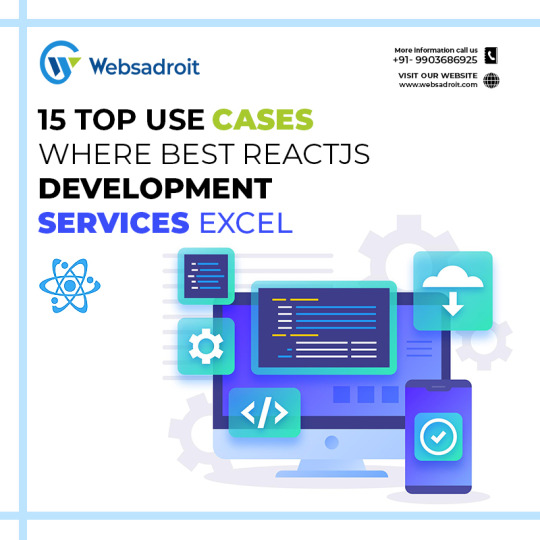
1. Single-Page Applications (SPAs)
React is renowned for building SPAs. Its component-driven architecture makes it possible to create reusable UI components. Such a feature makes it easier to manage complex user interfaces. React's virtual DOM efficiently updates only the parts of the page that change, resulting in a smooth user experience and faster load times.
2. E-commerce Websites
E-commerce platforms require dynamic and real-time updates. React's ability to handle complex user interfaces, product catalogues, shopping carts, and interactive features makes the best ReactJS development services excellent for building high-performance e-commerce websites.
3. Content Management Systems (CMS)
React is well-suited for developing intuitive admin dashboards for content management systems. It provides the flexibility needed to handle content creation, editing, and publishing, making it easier for content managers to work efficiently.
4. Progressive Web Apps (PWAs)
PWAs aim to provide a native app-like experience in the web browser. React's mobile-friendly design philosophy makes it a perfect fit for building PWAs that work seamlessly on various devices and offer features like offline support and push notifications.
5. Data Dashboards
Data visualization dashboards, used in business intelligence and data analysis, benefit greatly from React's component-based structure. React can be integrated with data visualization libraries like D3.js to create interactive and informative dashboards.
6. Cross-Platform Mobile Apps (React Native)
React Native, which is a framework with React as its base, allows developers to build native mobile applications for both iOS and Android using a single codebase. Such flexibility reduces development time and costs while maintaining a native app's performance, look and look-and-feel.
7. Social Media Platforms
Social media apps require frequent updates and dynamic content rendering. React's virtual DOM efficiently manages these updates, ensuring a smooth user experience in applications with complex interactions and real-time content.
8. Real-Time Collaboration Tools
Applications that involve real-time collaboration, such as collaborative document editors, project management tools, and chat applications, benefit from React's ability to handle dynamic data updates without requiring page reloads.
9. Online Learning Platforms
Online learning platforms can leverage React's interactive UI components to create engaging courses. Features like quizzes, video streaming, discussion forums, and interactive lessons can be implemented seamlessly.
10. Internet of Things (IoT) Dashboards
React can build dashboards in the IoT domain for monitoring and controlling IoT devices. Its capability to handle real-time data and updates is crucial for managing connected devices efficiently.
11. Booking and Reservation Systems
React can create booking and reservation systems for various industries, including travel, hospitality, and events. These systems require real-time availability updates and dynamic user interactions, which React handles well.
12. Healthcare Applications
React's ability to manage complex user interfaces makes it suitable for building healthcare applications such as electronic health record systems, telemedicine platforms, and health tracking apps that require a smooth and user-friendly experience.
13. Finance and Banking Applications
Security and performance are critical in finance applications. React's strong community support and libraries like Redux for state management make it reliable for building secure and responsive financial tools, including online banking platforms and financial analysis tools.
14. Marketplace Platforms
Building online marketplaces where users can list, buy, and sell products or services demands a robust and scalable front end. React's component reusability and efficient rendering make it an excellent choice for creating marketplace applications.
15. Gaming Dashboards and Admin Panels
React's ability to create responsive and dynamic user interfaces is valuable in developing gaming dashboards and admin panels. These panels allow game developers to monitor player data, analyze gameplay metrics, and manage in-game content efficiently.
In conclusion, React's versatility, performance, and robust community support make it an ideal choice for various development projects across different industries. Whether you're building a dynamic web application, a cross-platform mobile app, or a real-time collaboration tool, React provides the tools and capabilities needed to excel in modern web and mobile development. By harnessing React's strengths, developers can create powerful, user-friendly applications that meet the demands of today's digital landscape.
0 notes
Link
ReactJS for Dashboards and Data Visualization: An Exceptional Choice
🟢 Dashboards & data visualization importance
🟢 Significance of ReactJS for Dashboards and Data Visualizations in Modern Businesses
🟢 Types of Reactjs Charts
🟢 ReactJS for Dashboards & Data Visualization Examples
🟢 ReactJS Dashboard KPIs and Metrics
#reactjs for dashboards and data visualization#reactjs development#hire reactjs developers#reactjs devlopment services#software development#web development#dashboard and data visulization
0 notes
Text
React vs. React Native | What’s the Difference?
When you first read these terminologies, they might sound similar to you, but you might be aware of the differences if you are a tech recruiter. You may not know the exact distinction between the features and applications of these 2 popular web and mobile app development technologies.
This article is solely based on educating you on these differences so you can decide whether to hire React developers or hire React native developers in India.
Features and Application of React
While React and React Native share similar names and originate from Facebook, they have different characteristics and applications. React, or ReactJS is a JavaScript library used to build user interfaces for web applications. It has the following features and applications:
Features of React:
A virtual DOM efficiently updates and renders components for improved performance and faster UI updates.
React offers the provision of developing reusable UI components via a component-based approach. This makes it possible to build complex user interfaces.
React utilizes JSX, a syntax extension enabling the combination of JavaScript and HTML-like code for easy writing and understanding the structure of the components.
With a unidirectional data flow data changes can be predicted, and updates to the UI can be controlled.
The availability of powerful developer tools such as React DevTools makes it possible to inspect component hierarchy, monitor state changes, and debug applications.
Applications of React:
You can save the hassle and time of a full-page reload with React. This is because it’s used to build Single-Page Applications (SPAs) where the content is updated dynamically.
Whether you have a small-scale project or an enterprise-level web application development, React will fill in for your requirement. It’s widely adopted for developing interactive, compelling, responsive, and engaging applications.
User interface elements must be distinctive for a seamless user experience to steer ahead of the competition. React excels in creating complex and feature-rich user interfaces.
In the digital realm, users are acquainted with mobile apps more than web applications. React offers this convenience with the ability to develop progressive web apps. This means the abilities of mobile and web apps are combined to deliver an app-like experience to the users.
React offers efficient rendering via a component-based structure for building data-intensive dashboards and visualizing large datasets.
Features and Applications of React Native
Now it's time to understand what React native is and its features, making it a preferred choice for businesses to hire React native app developer India.
Features of React Native:
As the demand for both iOS and Android platforms is shooting up, developing web applications that can run efficiently on both is crucial. React Native saves you the time and effort of creating separate applications by providing cross-platform development using a single codebase.
Developers can view real-time changes in the application while preserving its original state in React Native. This hot reloading feature leads to agile development and debugging.
There is access to a wide range of device-specific APIs and native modules that make it possible to leverage platform-specific features and capabilities seamlessly.
A vast collection of third-party libraries and components exist for easy application integration.
Applications of React Native:
When you hire React native developers in India, their expertise helps build mobile applications for iOS and Android platforms with code reusability and a faster development cycle.
Delivering a consistent user experience is the key to successful web app development. React Native offers this by building applications that run on multiple platforms.
React Native balances performance and development efficiency by developing hybrid applications that combine web technologies with native UI components.
For applications with a heavy dependence on rich and interactive user interfaces like social media, e-commerce, and content-driven apps, React Native is an ideal solution.
Concluding Remarks
To conclude, React and React Native are related technologies with distinct purposes. While React is ideal for web development, React Native excels in mobile app development. React is a library for building web user interfaces; React native, on the other hand, is a framework for developing cross-platform mobile applications.
Therefore, you must choose wisely depending on your project requirements, target audience, budget, timeline, and development goals. Leverage the strength of appropriate technology to create exceptional user interfaces.
#hire React native developers in India#hire react native app developer india#Hire React Native Developers
0 notes
Text
Top 3 React UI Libraries in 2023: Enhance Your Projects
Introduction:
Discover the top 3 React UI libraries in 2023 that can help streamline your development process and create stunning user interfaces with ease. These libraries offer pre-built components, a variety of customization options, and excellent documentation to get you up and running quickly. By leveraging these powerful React UI frameworks, you can build responsive and visually appealing applications in no time. If you want to know more about React, then visit our page The React Company. Here you’ll get as much knowledge about it as you need.
Material-UI
Overview: Material-UI is a popular React UI library that implements Google’s Material Design guidelines, ensuring a modern and consistent user interface. With over 70k stars on GitHub, it has established itself as a reliable and widely-used choice among React developers.
Key Features:
Pre-built, customizable components
Robust theming system
Extensive documentation and community support
Supports server-side rendering
Integration with popular tools like Next.js and Gatsby
Example Use Cases:
Dashboard interfaces
Data tables and forms
Navigation menu
Short Code Example:
import React from 'react'; import { Button } from '@ mui/material'; function MyApp() { return ( <Button variant="contained" color="primary"> Click me </Button> ); } export default MyApp;
Chakra UI
Overview: Chakra UI is a flexible and modular React UI library that focuses on accessibility and ease of use, making it perfect for developers of all skill levels. With over 23k stars on GitHub, it has quickly gained traction as a go-to choice for building accessible and responsive applications.
Key Features:
Accessible components out of the box
Built-in theme support with easy customization
A wide variety of components and utilities
Supports dark mode
Emotion and Styled System integration
Example Use Cases:
Accessible web applications
Responsive designs
Customizable, modular component design
Short Code Example:
import React from 'react'; import { Button } from '@chakra-ui/react'; function MyApp() { return ( <Button colorScheme="blue" size="md"> Click me </Button> ); } export default MyApp;
Ant Design
Overview: Ant Design is a comprehensive React UI library that provides a vast array of high-quality components and a design system suitable for enterprise-level applications. With over 75k stars on GitHub, it is a well-established and trusted choice for many developers.
Key Features:
Over 50 customizable components
Internationalization support
Enterprise-focused design system
Built-in support for popular CSS preprocessors like Less and Sass
Responsive grid system
Example Use Cases:
Complex web applications
Admin panels and dashboards
Data-rich interfaces
Short Code Example:
import React from 'react'; import { Button } from 'antd'; function MyApp() { return ( <Button type="primary" shape="round"> Click me </Button> ); } export default MyApp;
Conclusion:

React UI Libraries
Choosing the right UI library for your React project can significantly impact the development process and the end result. Material-UI, Chakra UI, and Ant Design are three exceptional options to consider in 2023. Explore their documentation and examples to determine which library fits your project’s needs and requirements best. By using these powerful React UI frameworks, you can ensure that your applications are visually engaging, accessible, and responsive, setting you up for success in the competitive world of web development. If you want to know more about the React development then you can refer to: ReactJS Developments Trends 2023.
In addition to considering the features, community support, and use cases of each library, it’s essential to evaluate your project’s specific requirements and constraints. Factors such as team familiarity with the library, project size, and desired customization level should influence your decision.
To get started with any of these React UI libraries, visit their official websites and follow their step-by-step guides:
Material-UI: https://mui.com/ Chakra UI: https://chakra-ui.com/ Ant Design: https://ant.design/
By leveraging the power of these top React UI libraries in 2023, you can speed up your development process, maintain a consistent look and feel across your application, and deliver an outstanding user experience. With so many robust and feature-rich options available, there’s never been a better time to be a React developer.
So go ahead, explore the potential of Material-UI, Chakra UI, and Ant Design for your next React project, and unlock the full potential of these fantastic React UI libraries in creating web applications that stand out from the crowd.
0 notes
Text
CRMS — Sales, CRM, Accounts Admin Bootstrap Template (HTML + Laravel + Vuejs + Reactjs + Angular)
A CRM (Customer Relationship Management) template is a pre-designed website layout that helps businesses manage their customer interactions and data. The “Sales, CRM, Accounts Admin Bootstrap Template” specifically refers to a template built using the Bootstrap framework that is aimed at facilitating sales, customer relationship management, and account administration. Bootstrap CRM Admin Template Dashboard type of template can provide a basic structure for businesses to keep track of customer information, sales leads, and sales activities.
CRMs Vuejs Admin Website Templates specific features of a “CRMS — Sales, CRM, Accounts Admin Bootstrap Template” will vary depending on the exact template you are using, but some common features might include:
Dashboard: A centralized view of important data and metrics related to sales, customer relationships, and account management.
Customer Database: A database to store customer information, such as contact details, purchase history, and communication history.
Lead Management: A system for tracking and managing potential sales leads, including their status, follow-up activities, and conversion rates.
Sales Funnel: Best CRM Admin Templates visual representation of the sales process, from initial contact to close, to help track progress and identify areas for improvement.
Task Management: A system for organizing and tracking tasks related to sales, customer relationship management, and account administration.
Reporting and Analytics: Tools for generating reports and analyzing data to gain insights into the performance of the sales and customer relationship management process.
Mobile Responsiveness: CRM Angular Admin Website Templates ability for users to access the CRM on their mobile devices.
User Management: A system for managing users and assigning roles and permissions.
Integration with other tools:CRM Reactjs Admin Website Templates Ability to integrate with other business tools, such as email, marketing automation, and payment systems.
These are some of the common features of a CRM Sales, CRM, Accounts Admin Bootstrap Template, but the exact features will depend on the particular template you choose.
#admin dashboard#admin management dashboard#admin management template#bootstrap crm admin#crm#crm admin#crm admin template#crm dashboard#crm template#crms#customer management template#customer relationship management#project management#sales dashboard#task management
0 notes
Text
13 Best React Frameworks and Libraries to Use in 2025
ReactJS has improved, providing developers with different frameworks and components to ease UI development.

1. Material Tailwind — React
Material Tailwind is a popular design system and component library. You can use it with React, to create cool web apps.
It combines the good looks of Material Design with the practicality of Tailwind CSS.
You get lots of ready-made parts and styles to make your app look great without much effort.
If you want to build nice and easy-to-use web apps, Material Tailwind for React is a must-have handy tool.
Features-
Tailwind CSS with Material Design
Prebuilt components library
Easy customization
Responsiveness built-in
Tailwind CSS Integration
Dark mode support
2. Redux
Redux remains a vital state management library in the React community. It offers a smart approach to handling your app’s state and simplifies managing complex data flow.
With a rich set of middleware and tools, Redux keeps React applications well-organized, scalable, and efficient in managing their states.
Features-
State Management
Predictable State Updates
Centralized Store
Unidirectional Data Flow
Middleware Support
DevTools Integration
Community Ecosystem
3. Create a React App
Create React App streamlines the setup of new React projects. It provides a ready-to-go environment with a development server, build scripts, and necessary tools, enabling developers to dive into coding immediately without configuration headaches.
With ongoing updates to adapt to changes in the React ecosystem, Create React App remains a convenient option for rapid project launches.
Features-
Rapid Setup
Pre-configured Environment
Build Scripts
Zero Configuration
Dependency Management
Hot Reloading
Integrated Testing
4. Rebass
Rebass simplifies UI development in React, offering responsive and cohesive components.
With an emphasis on design principles and minimalism, Rebass delivers customizable and themeable UI elements.
It’s a great pick for effortlessly crafting visually appealing and user-friendly React apps.
Features-
Simplified UI Development
Responsive Components
Consistency Across Interfaces
Design Principles Emphasis
Minimalistic Approach
Highly Customizable
Themeability
Aesthetic Appeal
5. React Admin
React Admin is a framework designed to build admin interfaces and dashboards.
You can develop data-intensive applications using features like CRUD operations and efficient data handling.
With its focus on robust data and user management functionalities, React Admin proves to be an indispensable tool for developers.
Features-
Admin Interface and Dashboard Development
Streamlined Data-Heavy Application Development
CRUD Operations Support
Efficient Data Handling
Robust Data Management Functionalities
User Management Functionalities
Customizable Interface Components
Extensive Plugin Ecosystem
6. Ant Design
Ant Design is a widely-used UI library providing a diverse collection of meticulously crafted components for creating polished and intuitive applications.
It offers a variety of customizable elements like forms, tables, and navigation tools to simplify the React JS development services process, enabling the creation of sophisticated yet user-friendly React applications effortlessly.
Features-
Comprehensive UI Component Library
Meticulously Designed Components
Customizable Elements
Support for Forms
Feature-rich Tables
Navigation Components
Responsive Design
Theming and Styling Options
7. Grommet
Grommet stands out as a React UI component library celebrated for its emphasis on accessibility and ease of use.
Equipped with a suite of pre-built components, it places a strong focus on responsiveness and accessibility, making it an ideal choice for developers aiming to craft user-friendly web applications that meet accessibility standards.
Features-
Accessibility-Centric Design
User-Friendly Components
Responsive Layouts
Ready-to-Use Components
Simplified Development Process
Compliance with Accessibility Standards
Customization Options
Seamless Integration with React
Original Source of Content
0 notes
Text
Top Five Mobile App Development Company in Germany

There are Top Five Mobile App Development Company in Germany:
HireFullStackDeveloperIndia
HireFullStackDeveloperIndia offers front-end and full-stack JavaScript development services to craft business-centric solutions that range from simple desktop applications to mobile web applications and complex enterprise solutions. Their Full Stack developers leverage proven methodologies and best practices delivering applications at a high velocity and empower businesses to innovate with robust, scalable, and high-performance solutions.
Their proficiency in on-screen visual effects to processing and calculating data on web pages along with extending functionality to websites through third-party scripts and tracking code makes them one of the sought-after JavaScript development companies.
Data EximIT
For front-end web application development, their technicians use AngularJS, ReactJS, and NodeJS. These all frameworks allow them to create the best performing applications. Data EximIT is experts in developing migrations from AngularJS to ReactJS without any interruption in web application development. Data EximIT has developed complex frontend projects such as diagramming, video-based learning, social media-based dashboards, and real-time sports streaming. So if you wish to apply this approach, they can provide you with a cost-effective solution that will work for your business!
HourlyDeveloper.io
Their hugely-experienced team of developers is both fans and facilitators of using Full Stack technology to create beautifully-crafted websites & mobile apps with seamlessly performing APIs. HourlyDeveloper.io has an extensive understanding of JavaScript and have achieved huge success in dealing with the unique needs of a variety of clients across a range of industries. If you’d like to share in this success, simply contact them, and they can get started on a world-class Full Stack development solution just for you.
DataIT Solutions
Being a leading Full Stack Development Company, DataIT Solutions delivers end-to-end web or mobile app development services including ReactJS development and AngularJS development. They also have expertise in integrated JavaScript development, done with a number of server-side technologies such as JSP/JAVA, PHP/LAMP, Ruby on Rails, Python, etc. Through this simple, versatile, and effective language, they help their clients to extend the functionality on their websites.
Specializing in cross-platform projects as well as strict native modules, Data EximIT helps entrepreneurial business ideas by giving them the perfect app to suit their purpose. With a well-equipped team of developers working at offices in India, USA, Qatar, and Germany the organization has spent a great time in this exercise and can provide to you smartest approach to your project. This also makes it one of the top mobile app development company in Asia besides Germany and Europe.
Mobile phones have become like air for millions around the globe to access their work, their hobby, friends, family, and another network which entertain them. In this kind of era, everyone is taking the opportunity to expand the human reach or in business, language to reach international clients. One of the easiest methods to reach the global customer fast is a mobile application. Everyone owns one, and through right digital marketing, a mobile app can help generate lead and convert them into real clients.
Data EximIT is the top mobile app development company in Germany that provides every mobile application development solution a business might need.
0 notes
Text
Six smart steps to configure Mapbox with ReactJS
Mapbox provides custom maps, search and navigation. It supports many platforms. The tool is powered by programmers as well as millions of devices providing Location Data. It provides developers a platform and a toolset to build customized applications where location-based data can be used to meet a variety of business requirements.
A typical scenario where Mapbox is used:
A service provider uses Mapbox to track locations of their assets or employees in order to provide real-time information to customers or for operational monitoring. This could be a restaurant delivery service, an international transport company or even a fleet operator in a city.
Customizing Mapbox
One of our clients provides data services to monitor the health of agricultural farms. They wished to offer compelling data visualization of agricultural farm images along with other details. We customized mapbox to render this information on the web and mobile devices. There are SDKs available for the Web, iOS and Android.
In this article, we share how we configured mapbox in React JS using custom style to add new fonts, custom icons and publish these styles.
Following are the steps to configure mapbox in React JS using custom style to add new fonts, custom icons and publish these styles –
1. Steps to generate the token number and style in Mapbox
a. Create an account on https://account.mapbox.com
b. Log in to your account
c. On the Dashboard look for the Default public token. This Token number can be used for configuration in the Web App. You need to remember that this token number is public and easily accessible from the developer tab.
d. To get the private Token click on the button 'Create a Token' you will get a form. Enter the 'Token name' and select the desired 'Public Scope' and the 'Secret Scopes’.
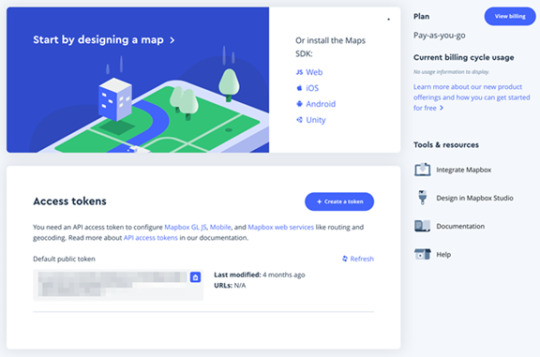
e. Note: - This token will only be accessible from the specific URLs that we add while generating the Token.
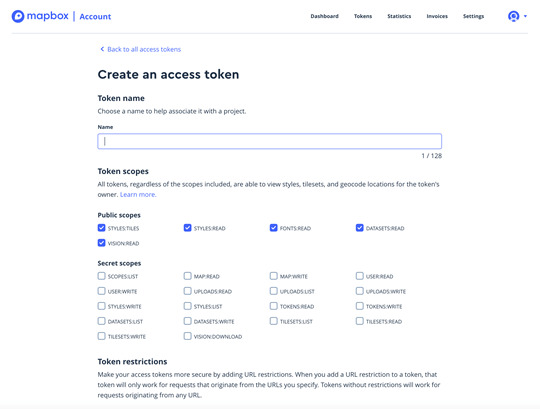
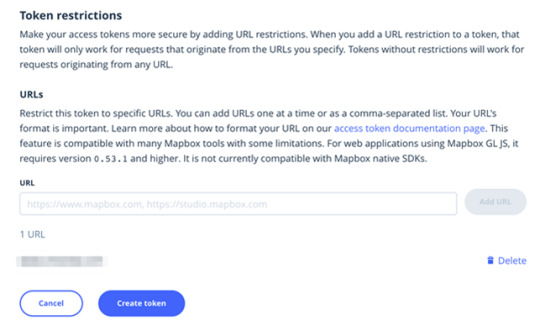
f. Now add the list of comma-separated URLs into the URL field and click on the 'Create Token’. Next you will be asked to confirm with your account password.
g. You will find the private token at the bottom of the Token list.
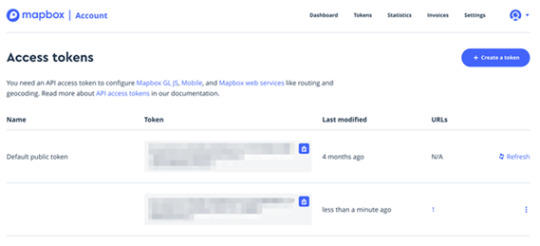
2. Steps to configure React JS app with Mapbox
a. There are two different methods available for using the Mapbox on the web App.We describe the steps using the 'npm' module bundler for installing Mapbox GL JS.
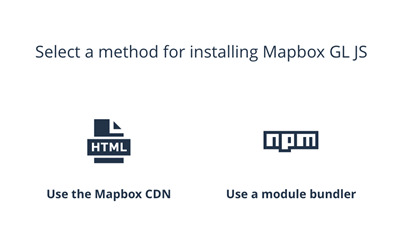
b. Install the 'npm' package --> 'npm install mapbox-gl --save'
c. Include the GL JS CSS file
d. Include the CSS file in the <head> of your HTML file
i. <link href='https://api.mapbox.com/mapbox-gl-js/v1.3.1/mapbox-gl.css' rel='stylesheet' />
e. Add the map to your Web App.
i. var mapboxgl = require(‘mapbox-gl/dist/mapbox-gl.js');
ii. mapboxgl.accessToken = 'Your Token number’;
iii. var map = new mapboxgl.Map({
iv. container: 'YOUR_CONTAINER_ELEMENT_ID',
v. style: 'mapbox://styles/mapbox/streets-v11' // Default style link
vi. });
f. Now you are done with the configuration.
3. Steps to create the custom style of Mapbox
a. To create our custom style for the map, we need to open the Mapbox Studio,
b. To open the Mapbox studio, you can to go to the Dashboard and then click on the 'Design in Mapbox Studio' on the right side of the Dashboard or Just click on the link here https://studio.mapbox.com/
c. After opening the Mapbox studio, you can see the predefined styles you can use directly or you may choose to create a new style.
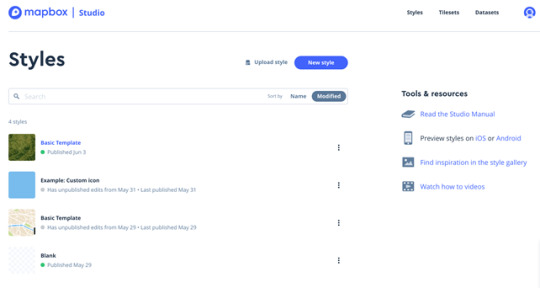
d. To create a new style, click on the 'New style' button on top of the page.
e. Select the desired template from the list and can change the style of the map from bottom of the dialog and then click on the customize button.
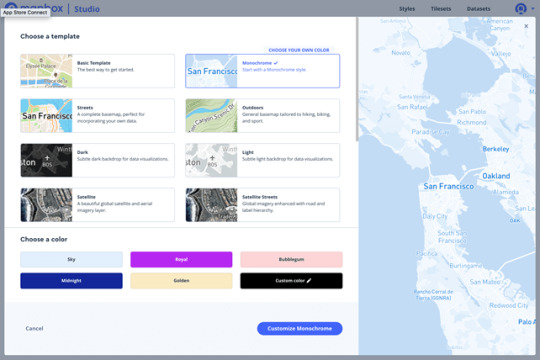
f. You can see a dashboard with different settings.
g. You can update the style of the country label, background, road, buildings and many more
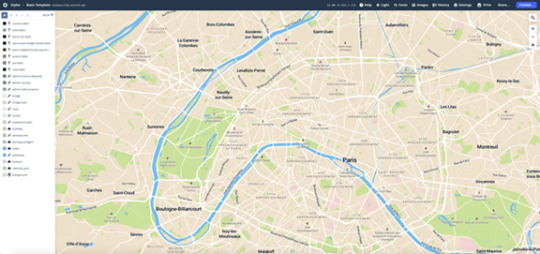

4. Steps to add a new font to the map and then publish for production
a. Click on the Fonts tab on the top-right corner then you can find a dialog to upload the new fonts.
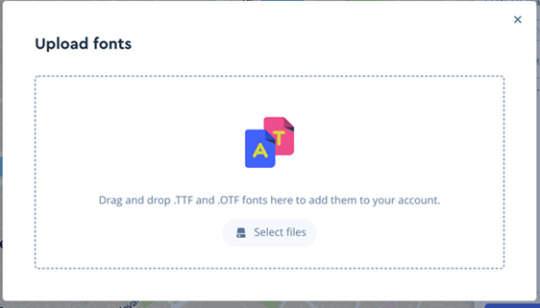
b. Clicking on the Upload new font, you can see a new dialog with the title 'Upload fonts' here you can drag new fonts with extension '.TTF' and ‘.OTF’.
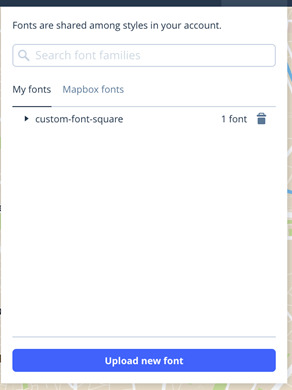
c. Once Font family is added, it can be then used in the map.

5. Steps to add a custom icon or an image and publish
a. The image we upload here will be available as an icon on the map for example Image as a custom marker.
b. Click on the 'Images' tab in the header you can see a dialog to upload the SVG image.
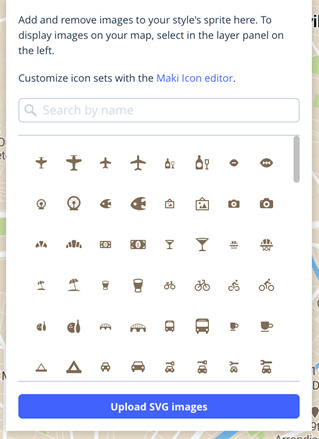
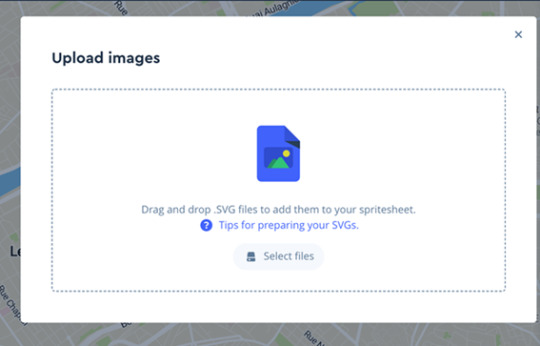
c. To upload the SVG image, click on the 'Upload SVG Icon' button, now you can see a new dialog where you can drag your SVG image.
d. Once you update any style, you have to publish the style to see the changes on the map.
e. Note: - It may take some time to get published and to reflect on the map.
f. It is very easy to publish the changes; you just have to click on the 'Publish' button on the top-right corner of the map box studio.
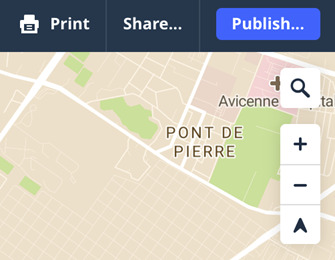
g. Now you can see a dialog with a slider where you can see the styles you added.
h. Here you can either ‘Publish as new’ which will replace all the styles, or, use the ‘Publish’ button to add the styles you added in your draft.
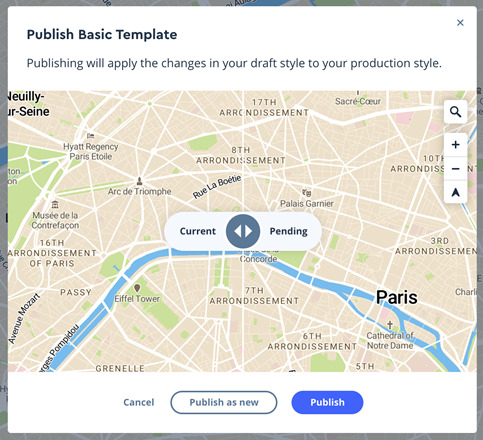
6. Steps to add the updated style to our map
a. Once the style is published,click on the 'Share' tab on the top-right corner of the Mapbox Studio. Here you can see a dialog where you can find your 'Your style Url' and 'Your access token’.
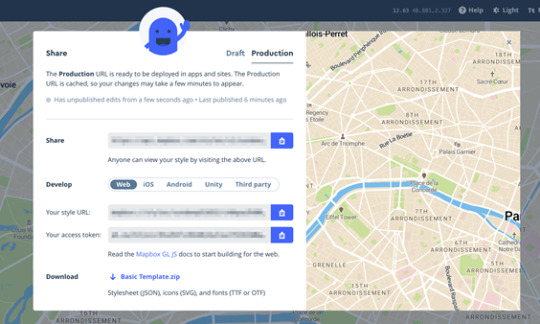
b. Now update your style URL of the map.
i. var map = new mapboxgl.Map({
ii. style: 'Add your style URL Here'
iii. });
c. Example:
i. const feature: feature<FeatureGeometry> = {
ii. id: 123,
iii. type: 'Feature',
iv. geometry: feature.geometry,
v. properties: {
1. meta: feature.meta,
2. icon: 'square-stroke'
3. // Custom Icon name which is added to the style in Mapbox Studio
vi. }
vii. }
For more information on our React projects please visit https://www.metasyssoftware.com/case-study-react
#Configuring Mapbox#mapbox#react#react native#reactjs#custommap#customizing Mapbox#mapbox studio#react customapp#react developers#reactjs app#reactjs example#reactjs web development company
0 notes
Photo

React Data Visualization - Build a Cryptocurrency Dashboard ☞ http://bit.ly/300q41c #reactjs #javascript
0 notes